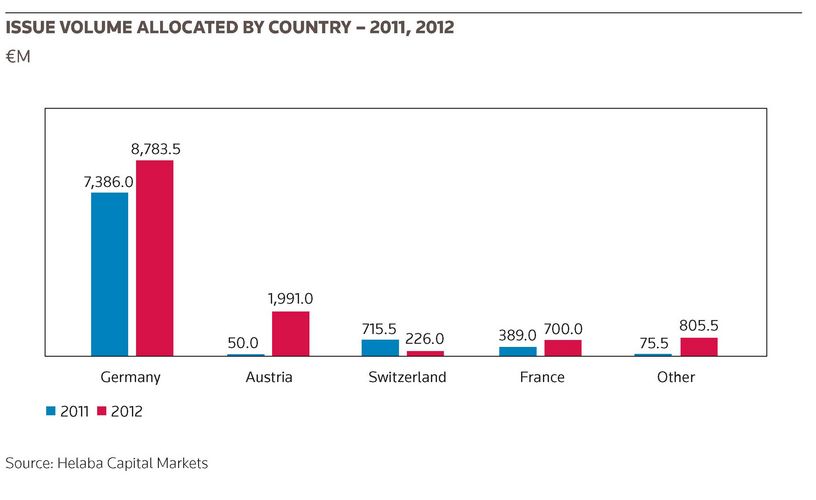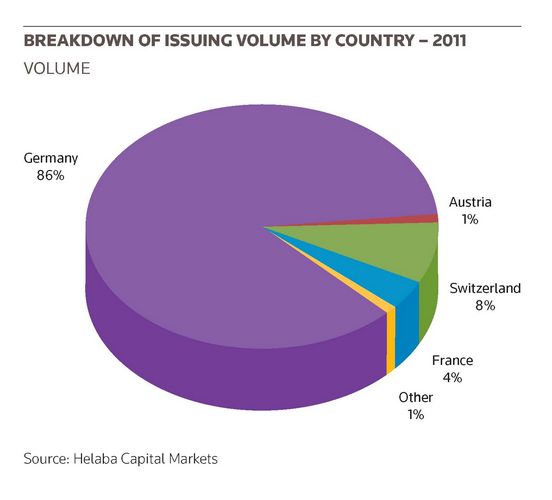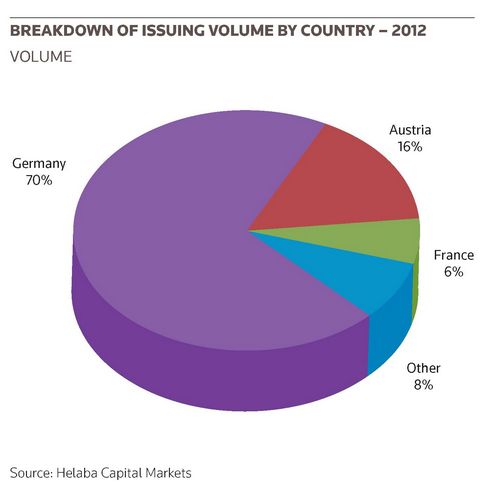To view the digital version, please click here.
IFR: One of the things I think is interesting as well, Paul is that as the market has expanded we’ve seen more examples of non-euro tranches and some completely non-euro denominated issues. What’s behind that trend? Do you think it will continue?
Paul Kuhn, BayernLB: I believe the main reason for that development is that the Schuldscheine market is obviously becoming more international, meaning we have more international issuers so there is demand for funds in different currencies. And the same on the investor side; if we are talking about Chinese investors or North American banks which have been investing quite actively in Schuldscheine recently, obviously they care about US dollars and in that case it’s very easy to bring both parties together.
Every single German company operating worldwide has a need for US dollars. However, the old investors, the investors who’ve been investing in Schuldscheine for 10 or 20 years won’t change their habits or their requirements. The new investors, being really international, being Asian, or South or North American, will be looking for foreign currency exposure.
IFR: Am I right in saying that non-euro Schuldscheine are not ECB eligible?
Paul Kuhn, BayernLB: Well, ECB eligibility is more geared to the fact that you aren’t supposed to have more than two jurisdictions; it’s not supposed to be a financial institution and it’s supposed to have an investment-grade rather than a non-investment grade rating. There are other categories that make it ECB eligible, but not currency.
Ansgar Wittenbrink, DZ Bank: Another reason for the currency diversification is the investors who want to buy non-euro corporate Schuldscheine want to create a relationship entry point into the issuers.
Raoul Hessling, Commerzbank: We do multi-tranches most of the time so every investor can decide what maturity he wants, what currency, and what interest-rate type. We don’t have to bother about whether US dollar funds are ECB eligible because the investor decides what preference he has. I think tranching offers a very fair approach to get the biggest investor community possible.
Richard Waddington, Commerzbank: It’s not as much of an issue now, but if you look back over the last 12-18 months at dollar funding in the European market, there’s been a premium associated with that in the loan market whereas on the Schuldschein side, you have investors with natural dollar liquidity so Schuldschein borrowers have not had to pay the same level of premium relative to if they were borrowing dollars from the European banks.
Johannes Maerklin, Deutsche Bank: One thing I’d like to mention is that we’re talking about the Schuldscheine market but there is a strong focus on the corporate side. In your opening comments, you compared it with the US PP market and asked whether the Schuldscheine market can keep up with it.
But it’s much bigger than the US PP market if you take into account all the different segments. This market derived from the public-sector side initially but there’s also financial institution risk; there is covered bond risk so it’s not only about corporates. There’s also a lot of agency risk as well as multilateral banks in this market, while a lot of the banks here have been bringing inaugural transactions for European sovereigns.
If you add this all up, last year, the Schuldscheine market was more than double the size of the US PP market.
IFR: How did the SSD market break down last year in terms of issuer type?
Johannes Maerklin, Deutsche Bank: Well, there was roughly €8bn-€10bn of corporate debt, at least €15bn from financials and even more from public sector issuers. And if you take into consideration all the covered bond-style instruments which from a legal point of view are the same as promissory notes, this is a huge market that’s handled more or less by the people sitting in this room. We would estimate that the market is above €80bn in volume per year.
Christian Porath, BNP Paribas: SSD are an important funding tool for banks, especially when it’s difficult to sell unsecured paper in the market.
Chrhistoph Zender, LBBW: There’s a very important difference between Schuldscheine issued by the public sector and financial institutions versus corporates. For public-sector issuers, the investor base is institutional while in the corporate sector, institutional demand makes up only 5% to 7%.
Johannes Maerklin, Deutsche Bank: Well, it depends on the type of company…
Chrhistoph Zender, LBBW: Sure I’m talking about the average breakdown. To improve Schuldscheine access for corporates, we have to work on the institutional side. Our goal is liquidity and we need more of it in the market. I think for us it’s very important to get more institutional investors into corporate Schuldscheine as well as international investors from the bank side.
Johannes Maerklin, Deutsche Bank: I think that’s what’s actually being done. If you look at what German insurance companies have been buying in recent years, they’re fully loaded with German public sector debt and with German or European covered bond risk so they’re switching right now. It’s a process that is currently in play.
Richard Waddington, Commerzbank: If you look at the US PP market relative to the European PP market, in terms of corporate issuance, the European market is starting to develop but it’s relatively small compared with the US in terms of long-dated corporate issuance. We are seeing pockets of demand and as institutions are looking to get more yield and access to corporate profiles they haven’t traditionally seen, we are seeing more reverse enquiry interest in that space, and I think that’s an area that is going to grow.
Richard Waddington, Commerzbank: If you look at the US PP market relative to the European PP market, in terms of long-dated corporate issuance, the European market is starting to develop but it still remains relatively small compared with the US market. We are seeing pockets of demand and as institutions are looking to get more yield and access to corporate profiles they haven’t traditionally seen, we are seeing more reverse enquiry interest in that space, and we think that this is an area where demand is going to grow.
Across the different geographies, we’re seeing different products competing in that space. You have Schuldscheine in Germany and you see private placements in the French market but there’s no harmonisation like you see in the US so it’s going to be interesting to see how this market evolves over time But I feel that Schuldscheine is well placed to be internationalised.
Claudia Hopstein, HSBC Germany: There’s a clear trend here: more institutional investors are looking at the private placement market, particularly for the Schuldscheine product. The typical German insurance companies or pension funds might be used to it but UK insurance companies have traditionally looked more into the US PP product. Now they’re realising that with the new regulations and capital needs, they have demand for other private placement products.
They’re clearly analysing what they can do. It’s also about documentation: can they accept lean German documentation versus US PP standards or any unrated paper? But I think there’s a very strong and clear trend, and we’re going to see them soon as they are facing internal pressure to invest.
Christian Porath, BNP Paribas: The issue of rating is important. It’s very easy with a DAX company or a rated company but it’s more difficult to sell an unrated corporate issue to an insurance company. And this is because they don’t have the internal credit systems that banks generally have. One of the successes of the structure of the German banks is that they can carry out the credit analysis and pass it on to the constituent Sparkassen or Volksbanken whereas with institutional investors you’re taking more of a reputational risk so this won’t happen.
Institutional buyers need ratings because – other than the major firms – they can’t do their own credit analysis. A typical pension fund in Germany wouldn’t have a credit committee so this market needs to have other credit rating agencies.
Claudia Hopstein, HSBC Germany: Well, we have already seen the start of that trend, with insurance companies accepting Euler Hermes ratings for example. But the investor base is split into two parts: you have the short-term savings bank-oriented segment, which has different price sensitivities to the longer-term orientated institutional insurance companies and pension funds. At the end of the day, it’s good for corporate Germany and corporate Europe because it creates a broader choice with more flexibility so you can structure deals more in line with the requirements of the issuer.
Paul Kuhn, BayernLB: One proof of this change is that several insurance companies and pension funds are changing their own policies and regulations so where in the past they were only allowed to invest maybe 5% of their funds in unrated vehicles; as they’ve seen this liquidity shift and the fact that you can’t reach so many hidden champions or interesting and well-qualified issuers other than by investing in Schuldscheine, they’ve changed this allocation. I’ve heard from some investors that they’ve doubled or tripled the levels of investment allowed into unrated vehicles.
The investor base is determining whether they can accept internal ratings or not. If you’re a small regional bank and the internal rating has been assigned from within the same organisation, they will accept your rating. Bigger investors don’t care whatsoever about our internal ratings and will do their own analysis anyway.
Ansger Wittenbrink, DZ Bank: But it depends on the maturity; and from my perspective, it’s totally different. We typically see three, five and seven-year maturities with just a few 10-year maturities in the corporate Schuldschein market. Sparkassen and Volksbanken are involved in around 70% of three to seven-year corporate Schuldscheine issuance; there are around 1,100 Volksbanken and 400 Sparkassen in Germany.
Insurance companies are the main investors in the 10 year maturities because of the higher required yield. But only 15% of issuance is in the 10-year or longer sector. This is relatively low compared to the other maturities. That means insurance companies are not the main driver in the corporate Schuldschein market.
Richard Waddington, Commerzbank: You’ve got different investor bases in the sector with different demand drivers; that’s what makes it such an interesting space. You have the German landscape where there is a certain type of investor and there is the international space which fundamentally has a different investor base. There is clearly some overlap for certain borrowers but overall it’s a diverse investor base and one that is growing.
Christian Porath, BNP Paribas: The stars are aligned now for these investors you can only reach the yield targets with long duration because we’re in a low rate environment. If rates go to 2% then I think there will be less demand for corporate Schuldscheine from institutional investors and we will go back to the normal maturities. So a lower rate environment is actually helping a lot.
Paul Kuhn, BayernLB: The beauty of the Schuldscheine as I see it is you can really combine long and short-term maturities for different kind of investor bases. At the very beginning of the process, you listen to the issuer and understand what goals he is aiming for and what’s important for them and what kind of investor base they’re focusing on.
That’s something you take into account during the marketing process. We did a transaction with HSBC where we had seven or eight different maturities going out to 20 years. At the upper end, we mainly had investors from the insurance and pension fund sector; in the short-term maturities, it was mainly the regular investors: saving banks, regional banks and so on. And we achieved that without any additional marketing. In just one deal, we combined pretty much the entire gamut of investors.
Raoul Hessling, Commerzbank: I think this is one of the key developments that we saw last year, that arrangers actually adjusted the structures by adding these 10 year tranches. This was one of the key trends. And the other key trend was the US dollar tranches as well, that kicked in really last year. We saw that back in 2008 and but it died for some years but now they’re really back.
Hans Niethammer, Unicredit: When you talk about the investor universe for corporate Schuldscheine, an important question is whether the market will be able to increase liquidity within the secondary market. One limiting factor could be that many typical Schuldscheine issuers are family-owned businesses, which tend to look for privacy and confidentiality. They like to know who’s holding their Schuldscheine so this could clearly limit the potential of a strong increase in secondary market liquidity for this market.
Hassan Farhadi, Helaba: To summarise what everyone has said in the past 20-30 minutes: everyone has well established experiences with Schuldscheine talking from the investor and borrower perspectives; whether it’s rated or unrated; ECB eligible or not; multi-currency, capital market, funded investors or real-money accounts and the experiences we’ve collected show that the Schuldscheine is an asset for almost every situation, and that’s the beauty of it. It’s one size fits all.
Paul Kuhn, BayernLB: We call it tailor-made.
Oliver Rupprecht, NordLB: It’s so easy and so much faster for a company to get into Schuldscheine than into a corporate bond.
Hassan Farhadi, Helaba: And you know talking about the speed of the transaction, with Schuldscheine, we tend to give investors about four weeks in general but from time to time, when we have underwritten a mandate and taken all the positions onto our trading book, some investors don’t realise that if they receive an invitation on Friday afternoon and the value-date was the following Monday, by the following Monday, we already have the subscription certificate. So it just shows that if you apply some pressure, it can work as well. This shouldn’t be the general name of the game, but it’s growing and Schuldscheine are becoming a more solid and valuable instrument within the capital markets world.
Schuldscheine Roundtable 2013: Part 3



